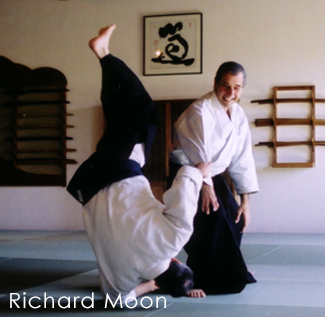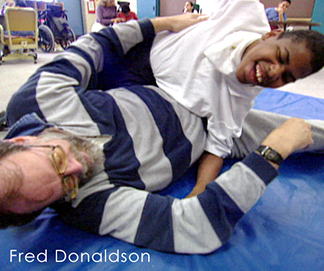
Outside our gallery on a busy tourist sidewalk a frustrated three year old sits on the ground and refuses to budge. Her mother is furious. “No,” shouts the little one. “Get up right this minute!” Again, “No,” cries the toddler. The mother reaches down, grabs the now screaming girl by the legs, holds her up-sided-down and shakes her violently, while the raging woman’s husband and older child stand by – saying nothing. This is what happens when we pick a fight with a toddler. No one wins and the collateral damage, long term, is crippling. What goes around – comes around. Maybe not right away, at age ten or fifteen or twenty five.
How would an Aikido Master meet a toddler’s demands, their quick temper and sometimes tears? Aikido is often translated as “the way of harmonious spirit.” The founder’s goal was to create an art the practitioners could use to defend themselves while also protecting their attacker. Aikido is unusual for this emphasis on protecting the opponent, in this case our children, as part of one’s spiritual and social development. Ueshiba, the founder, developed Aikido after experiencing several spiritual awakenings. He said:
The Way of the Warrior has been misunderstood. It is not a means to kill and destroy others. Those who seek to compete and better one another are making a terrible mistake. To smash, injure, or destroy is the worst thing a human being can do. The real Way of a Warrior is to prevent such slaughter – it is the Art of Peace, the power of love… The source of budō [the martial way] is God’s love – the spirit of loving protection for all beings.”
Parenting and Aikido have a lot in common. Both are arts, a spontaneous creative flow where the student (and all parents are students) meet their needs while simultaneously meeting the needs of the child. Instead of meeting on the dojo mat, we meet our toddler challenges in play.
After our evening bath it is time to dress for the night. I fluff and wrap Carly in a lovely hooded robe with a soft fuzzy lining. With her on the sink we brush my teeth and hers, perhaps shave, dab cream where needed, on Carly and me, then it is off to the bed, sans the frame and box springs, just a mattress on the floor. Carly’s mattress is tucked next to ours between the night table. Pillows are stuffed in the corners making it ideal for jumping, rolling climbing, a safe place complete with a cave and tunnels by simply lifting a foot.
When I said off to bed I did not mean it was time to sleep. That comes later. First it is time to dress. In a giggling snap the robe disappears. I hold up Carly’s jammies. She shakes her head, no way, and runs down the hall leaving me dangling the P.J’s. Where’s Carly? My shuffling feet alert anyone hiding that I am coming near. Out she runs, butt naked, laughing, I shuffling after holding up the P.J’s. This is how we get dressed at night. Like a toddler-Aikido master the trick is to not fight her protests, rather play along with them until she slips effortlessly into her jammies as part of the play. Soon enough and that is the key, to focus on the play rather than making demands, she eagerly lays in place, one foot in the air and then the other. The moment play ends demands begin and then comes conflict. Everything changes.
What I find so interesting is how time often plays a central role in conflict. We make up some arbitrary deadline, like Now! And we expect our tiny ones to conform. If not we get all bent out of shape. If play is the guiding principle this time factor doesn’t seem to apply. One of the hallmarks of authentic play is complete attention. The activity is so interesting, not to mention fun and pleasurable, that time seems to disappear. Who cares if the jammies slip on now or in three minutes? The real goal is to keep the play moving. Demands don’t exist in original play.
But I hear you protest; ‘we are serious, busy adults. We have rules, regulations, priorities, schedules and responsibilities.’ Our little ones don’t live in that world. They are in the moment and this moment is for play. We have to appreciate that Play is Learning, learning how to relate, what this new object feels like, what it fits in or does not, what does it taste like and how to relate to others is all part of the child’s play continuum. To break this flow to meet some, to them unknown and abstract demand, is a betrayal of what nature demands Carly does, learn and discover in the optimum state for learning and discovery called play.
When we realize that the state of the relationship is infinitely more important than meeting a demand de jour, we give precedent to that, the quality of the relationship. That is where parenting and Aikido meet. The warrior bent on beating relates completely differently than one who meets his or her needs while simultaneously protecting and therefore meeting the needs others.
I had the good fortune to meet Richard Moon, Sensei, 6th Dan, who began his study of Aikido in 1971. Richard founded Aikido of Marin and co-founded City Aikido with his teacher Nadeau Sensei. Richard has taught in New Zealand, Australia, Switzerland, Holland and numerous seminars in the United States. Richard and I share being inspired by David Bohm’s Dialogue process the spirit of which Richard equates to Aikido and I to spontaneous play. And not by coincidence Fred Donaldson, original play researcher, is also an Aikido practitioner. Anyone watching Richard or Fred on the mat will notice a light, flowing, spontaneous playful spirit. Apply that to the mother holding her screaming three year old by the legs and shaking. It would never happen. What we call the ‘terrible twos’ is brought about by the clash of two self-world views; expectation, authority and demands vs. original play. The transforming insight is that original play takes place in a space of mutual love, trust and respect. It is not the goal or demand that matters, it is the relationship and the optimum relationship for learning and performance, at any age or stage, is authentic play.
In play, keeping the shared joy, the shared pleasure and spontaneous creativity moving is the overarching priority even when we ‘dults’ have our oh-so very important responsibilities with our equally so-important demands. The nature and quality of the relationships transcends these fleeting pressures every time. Most conflicts don’t happen. The job gets done with grace and ease.
After the bath I grab Carly’s PJ’s and run down the hall, hiding in plain sight on the middle of the floor in a dark room. Footsteps! I tap my finger on the floor. Carly giggles, runs in the room, jumps on my tummy and amazingly the jammies slip into place in less time than if we fought about it. All it takes is love, trust, respect and a dash of playful imagination.
Michael Mendizza
 |
 |